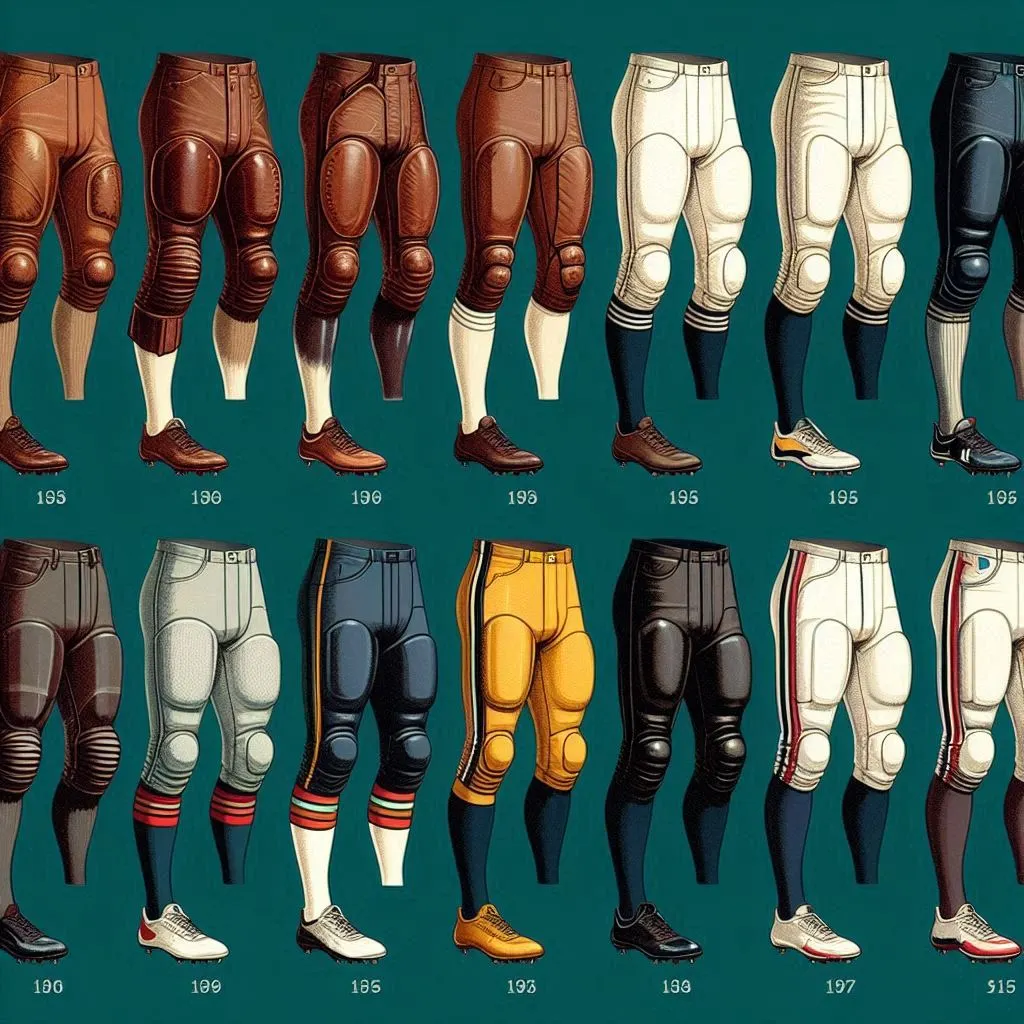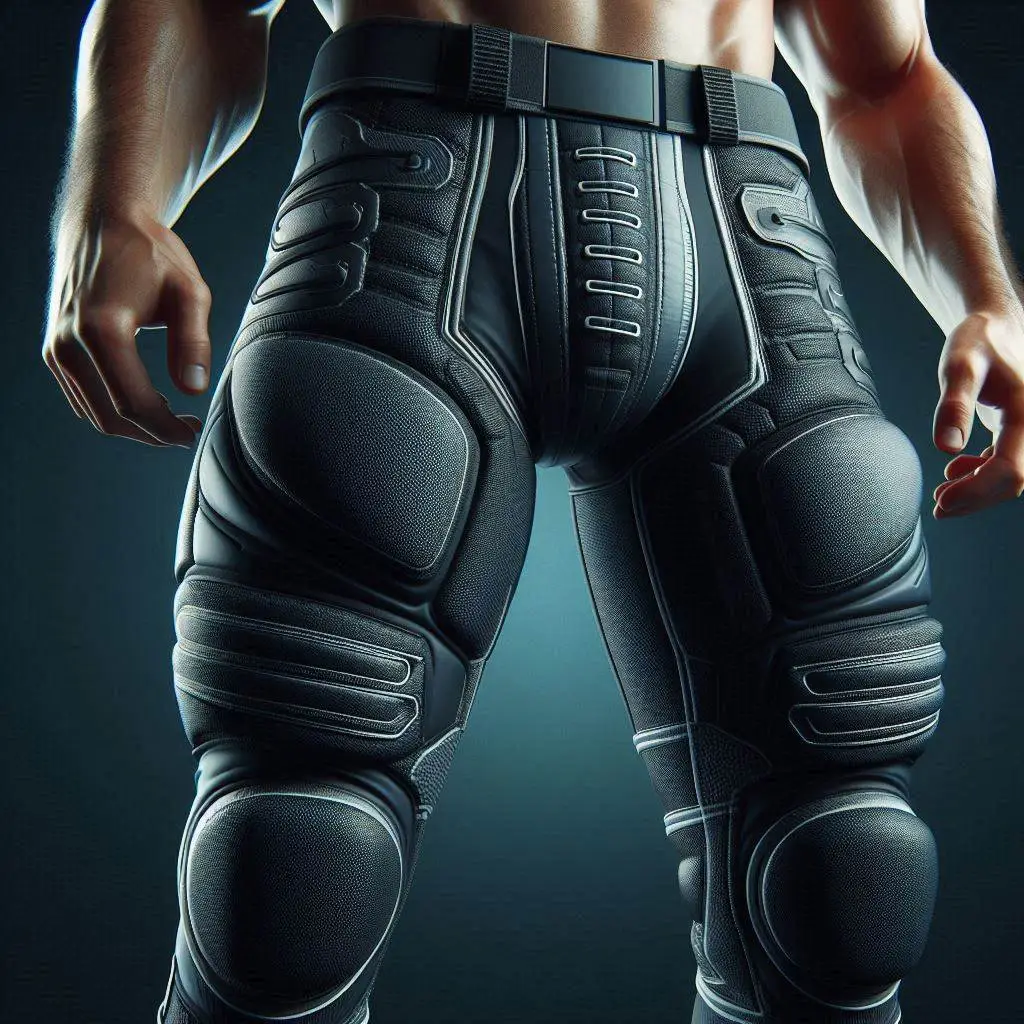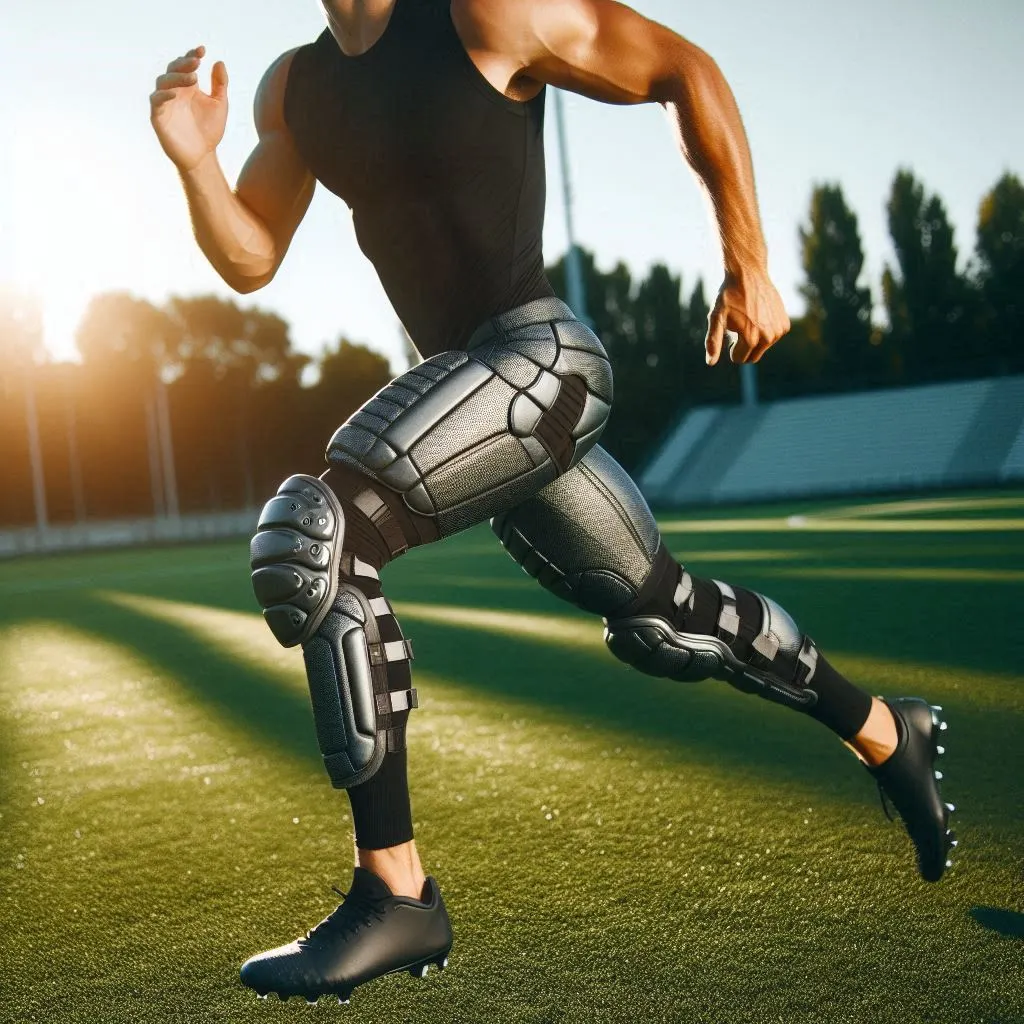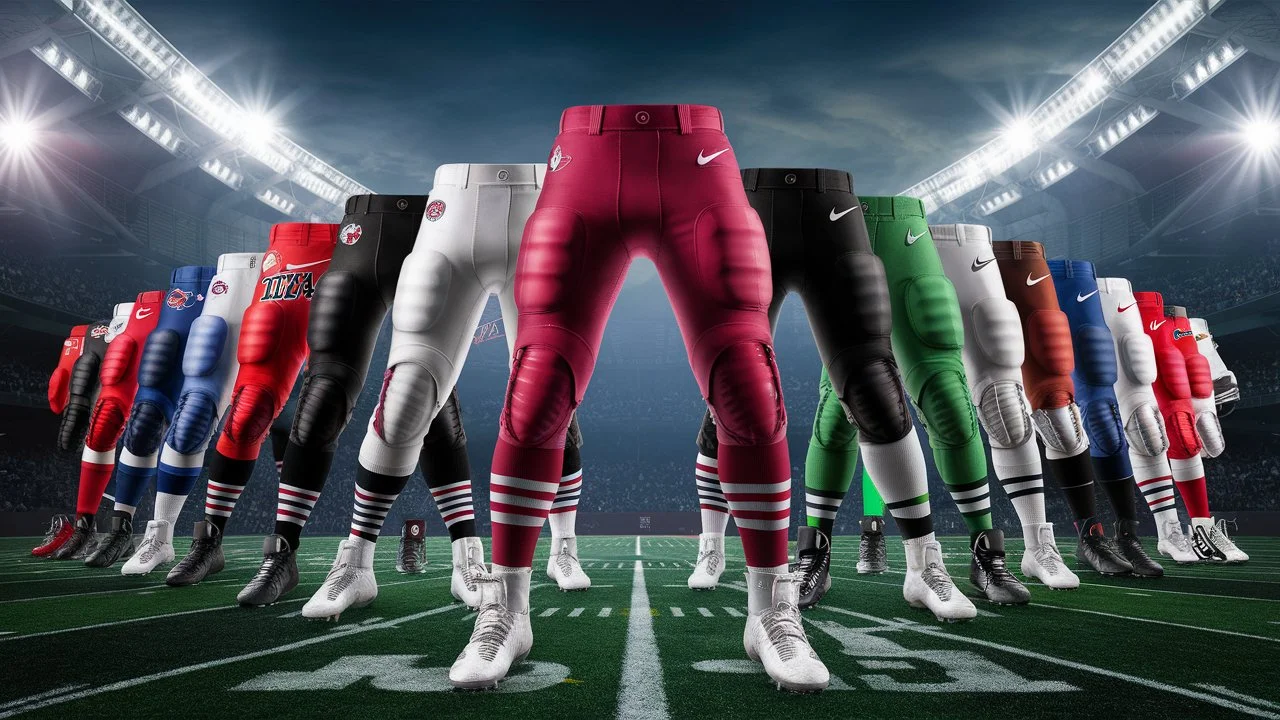Football pants are more than just a part of a player’s uniform; they are essential gear that plays a significant role in the game. These pants, designed with both performance and safety in mind, are crucial for every football player, from amateurs to professionals. Understanding what football pants are called, their components, and their importance can enhance our appreciation of the game and the gear behind it.
- Importance of Football Pants: Football pants are designed to provide maximum protection and comfort for players. They are equipped with padding that safeguards key areas like the thighs, knees, hips, and tailbone, helping to prevent injuries during intense gameplay.
- Design and Evolution: The design of football pants has evolved significantly over the years. From simple, unpadded trousers in the early days of the sport to the advanced, high-performance gear used today, football pants have undergone many changes to meet the demands of modern football.
- Purpose of This Article: This article aims to delve into the world of football pants, unveiling the gear behind the game. We will explore the history, components, types, brands, and the impact of football pants on player performance and safety. Additionally, we’ll provide insights on how to choose the right football pants, debunk common misconceptions, and look at the future of football pants.
By the end of this article, readers will have a comprehensive understanding of football pants and their essential role in football. Let’s dive into the basics of football pants and discover what makes them so important.
The Basics of Football Pants
Definition: What Are Football Pants?
Football pants are specialized athletic wear designed for football players. These pants are integral to the uniform and are tailored to provide both protection and flexibility. They are typically made from durable materials like nylon, spandex, and polyester, which allow for a snug fit while enabling a full range of motion.
Purpose: Why Are They Essential in Football?
Football pants are essential because they:
- Protect Players: Equipped with padding in critical areas such as the thighs, knees, hips, and tailbone, they help minimize injuries from tackles, falls, and collisions.
- Enhance Performance: The snug fit and flexible materials allow players to move freely, ensuring that they can sprint, tackle, and maneuver without restriction.
- Maintain Uniformity: They contribute to the team’s uniform, ensuring all players look cohesive and professional on the field.
Terminology: Different Names and Variations
Football pants are known by several names, each reflecting their specific use or design:
- Game Pants: These are the pants worn during official games. They are designed to meet regulations and often feature more advanced materials and padding.
- Practice Pants: Typically more durable and less expensive than game pants, these are used during training sessions. They might have fewer features and less padding but are built to withstand rigorous practice routines.
- Integrated Pants: Some football pants come with built-in pads, offering convenience and ensuring that padding stays in place.
Understanding these basic aspects of football pants helps in appreciating their role in the game. Next, we will delve into the history of football pants, tracing their evolution from the early days of football to the high-tech gear we see today.
History of Football Pants

Early Days: Origin and Evolution of Football Pants
In the early days of football, the gear was rudimentary and primarily focused on functionality. Players wore simple, unpadded trousers made from basic fabrics. These early football pants offered little in terms of protection or flexibility, which often led to injuries.
- 1880s-1900s: Football pants initially resembled knickerbockers, with laces at the knees and minimal padding. They were usually made from heavy wool or canvas, which provided some durability but limited mobility.
- 1910s-1930s: As the sport grew in popularity, the need for better protective gear became apparent. During this period, players began to experiment with adding rudimentary pads made from leather or other thick materials to their pants.
Key Milestones: Changes in Design and Materials Over the Years
The evolution of football pants saw several key milestones, each improving the safety and performance of the players.
- 1940s-1950s: The introduction of synthetic materials like nylon and polyester marked a significant advancement. These materials were lighter and more flexible, allowing for better movement on the field. Padding also became more standardized, with thigh and knee pads being sewn into the pants.
- 1960s-1980s: This era saw the refinement of padding and the introduction of hip and tailbone pads. Manufacturers began to design pants with pockets specifically for pads, making them removable and more customizable.
- 1990s-Present: Modern football pants are made from advanced fabrics that wick moisture away from the body, keeping players dry and comfortable. The padding is now made from high-density foams and other advanced materials that offer better protection while being lightweight.
Influence of Technology: How Advancements Have Shaped Modern Football Pants
Technology has played a crucial role in the development of football pants, enhancing both their protective qualities and comfort.
- Moisture-Wicking Fabrics: Today’s football pants use fabrics that help keep players dry by wicking sweat away from the skin. This not only enhances comfort but also helps prevent chafing and other skin irritations.
- High-Density Padding: Modern padding materials are lighter and more effective at absorbing impacts. This includes advanced foams and gel pads that offer superior protection without adding bulk.
- Ergonomic Design: Football pants are now designed with ergonomics in mind, ensuring that they move with the player’s body. This includes features like stretch panels and anatomical cuts that provide a better fit and greater flexibility.
Understanding the history and technological advancements of football pants gives us a deeper appreciation of how far the gear has come. The next section will break down the various components of football pants, exploring the materials and design features that make them essential for the game.
Components of Football Pants

Materials: Common Materials Used
Football pants are crafted from a variety of materials designed to balance durability, flexibility, and comfort.
- Nylon: Known for its strength and resistance to abrasion, nylon is commonly used in football pants. It provides a durable outer layer that withstands the roughness of the game.
- Spandex: This material adds stretch to football pants, ensuring a snug fit that moves with the player. Spandex allows for greater flexibility and a full range of motion.
- Polyester: Often used for its moisture-wicking properties, polyester helps keep players dry by drawing sweat away from the skin. It is also lightweight, which adds to the overall comfort.
Design Features: Key Features of Football Pants
Football pants incorporate several design elements that enhance performance and protection.
- Padding Pockets: These are built-in compartments that hold various pads in place. They ensure that padding stays securely positioned during gameplay, providing consistent protection.
- Belts and Fasteners: Integrated belts or drawstrings help secure the pants at the waist, ensuring they stay in place during vigorous movements. Some pants also have additional fasteners like zippers or Velcro for a better fit.
- Ventilation Panels: To enhance breathability, some football pants feature mesh panels or ventilation zones. These help regulate temperature and keep players cool, especially during intense matches.
Pads and Protection: Types of Pads and Their Importance
One of the most crucial aspects of football pants is the padding. These pads are strategically placed to protect key areas of the body.
- Thigh Pads: Located on the front of the thighs, these pads protect against impacts and collisions. They are essential for absorbing the force of tackles and falls.
- Knee Pads: Positioned over the knees, these pads help prevent injuries from direct blows. Knee pads are vital for protecting one of the most vulnerable joints in the body.
- Hip Pads: These pads cover the hip bones and are crucial for side impacts. They protect the hips from hard hits and falls.
- Tailbone Pads: Found at the back of the pants, these pads shield the tailbone from injuries. They are particularly important for preventing bruises and fractures from backward falls.
Additional Features
Football pants often include other features that enhance their functionality and player comfort.
- Stretch Panels: These are sections of fabric with added elasticity, allowing for greater movement and flexibility. Stretch panels are typically located in areas that require the most mobility, such as the groin and sides.
- Reinforced Seams: To ensure durability, the seams of football pants are often reinforced. This prevents tearing and extends the lifespan of the pants.
- Moisture-Wicking Technology: Advanced materials that wick moisture away from the skin help keep players dry and comfortable, reducing the risk of chafing and irritation.
Understanding the components of football pants provides insight into how they are designed to protect and enhance a player’s performance. Next, we will explore the different types of football pants, detailing the characteristics and specific uses of game pants, practice pants, and custom options.
Types of Football Pants
Game Pants: Characteristics and Features
Game pants are specifically designed for official matches. They combine advanced materials and design features to enhance performance and provide maximum protection.
- High-Quality Materials: Game pants are made from premium fabrics like polyester blends with spandex for stretch. These materials offer durability, flexibility, and moisture-wicking properties.
- Advanced Padding: Game pants typically feature high-density foam pads that are lightweight yet offer superior protection. These pads are strategically placed to cover the thighs, knees, hips, and tailbone.
- Snug Fit: The fit of game pants is crucial. They are designed to be form-fitting to reduce drag and allow for maximum mobility. The snug fit also ensures that pads stay securely in place.
- Team Colors and Logos: Game pants often incorporate team colors and logos, contributing to the team’s uniform look. They can also include stripes or other design elements that represent the team.
Practice Pants: Differences from Game Pants
Practice pants are intended for training sessions and scrimmages. While they share some similarities with game pants, they have distinct differences tailored to the needs of practice routines.
- Durability: Practice pants are built to withstand frequent use and rough handling. They may use slightly heavier fabrics that can endure the wear and tear of regular practice.
- Basic Padding: These pants often have more basic padding compared to game pants. While still protective, the padding might be less advanced and more focused on durability.
- Cost-Effective: Practice pants are usually more affordable than game pants. This makes them ideal for regular use without worrying about excessive wear and tear.
- Simpler Design: Practice pants typically have a simpler design without team logos or intricate detailing. They focus on functionality over aesthetics.
Custom and Specialized Pants: Options for Different Positions and Needs
Custom and specialized football pants cater to the unique requirements of different player positions and individual needs.
- Position-Specific Pants: Different positions on the field have unique needs. For example, linemen might prefer pants with extra padding around the thighs and hips for better protection during physical play. In contrast, wide receivers might opt for lighter pants with minimal padding to maximize speed and agility.
- Integrated Pants: These pants come with built-in pads, offering convenience and ensuring consistent protection. Integrated pants are particularly popular among younger players and those who prefer a streamlined approach to their gear.
- Compression Pants: Some players wear compression pants underneath their football pants. These pants provide muscle support, improve blood circulation, and help reduce fatigue. They also offer a base layer of protection and can help with temperature regulation.
- Custom Fit and Design: Many brands offer customization options for teams and individual players. This includes custom sizing for a perfect fit, as well as personalized design elements like team logos, player numbers, and color schemes.
Understanding the various types of football pants helps players and teams choose the right gear for their needs. Next, we will delve into the major brands and manufacturers of football pants, comparing their offerings and highlighting their unique features and innovations.
Brands and Manufacturers
Major Brands: Overview of Leading Brands
Several brands dominate the market for football pants, each offering unique features and innovations. Here are some of the leading names:
- Nike: Known for its high-performance athletic gear, Nike football pants are popular for their durability, advanced materials, and sleek design. Nike often integrates moisture-wicking technology and ergonomic designs to enhance player comfort and performance.
- Under Armour: Under Armour football pants are renowned for their innovative materials and compression technology. They focus on providing a snug fit that supports muscle performance and reduces fatigue, with features like HeatGear® fabric to keep players cool.
- Adidas: Adidas combines traditional craftsmanship with modern technology in their football pants. Known for their Climalite® fabric, which wicks away moisture, Adidas pants are designed to keep players dry and comfortable while offering robust protection.
- Riddell: As a brand synonymous with football gear, Riddell offers football pants that emphasize protection and durability. Their pants often feature high-density padding and reinforced seams, catering to players looking for extra safety features.
Comparison: Key Differences and Unique Selling Points
While all major brands aim to provide top-quality football pants, each has its unique selling points that cater to different preferences and needs.
- Nike vs. Under Armour: Nike focuses on overall performance with lightweight materials and advanced moisture management, making them ideal for players seeking speed and agility. Under Armour, on the other hand, emphasizes muscle support and compression, perfect for players looking to enhance their endurance and recovery.
- Adidas vs. Riddell: Adidas offers a balance of performance and comfort, with a strong emphasis on moisture management and flexibility. Riddell prioritizes protection, with more substantial padding and reinforced construction, making them suitable for players in high-impact positions.
- Customization Options: Some brands, like Adidas and Nike, offer extensive customization options for teams, allowing for personalized designs and tailored fits. This can be a significant advantage for teams looking to maintain a cohesive and professional appearance.
Innovations: Recent Innovations in Football Pants Design and Technology
The football gear industry continually evolves, with brands introducing new technologies and features to enhance performance and protection.
- Moisture Management: Advanced fabrics that effectively wick moisture away from the skin are a standard feature in modern football pants. Brands like Under Armour and Adidas lead in this area, ensuring players remain dry and comfortable.
- Ergonomic Design: Football pants are now designed to follow the natural movements of the body. Stretch panels and anatomical cuts provide a better fit and greater mobility, seen in Nike and Under Armour products.
- Integrated Pads: Many modern football pants feature integrated padding, which eliminates the need for separate pad inserts. This design ensures consistent protection and a more streamlined fit. Riddell and Nike have been at the forefront of this innovation.
- Enhanced Durability: Brands like Riddell focus on creating football pants with reinforced seams and durable materials to withstand the rigors of the game. These features ensure longevity, even with frequent use and rough play.
- Compression Technology: Under Armour has pioneered the use of compression fabrics in football pants. This technology helps improve blood flow, reduce muscle fatigue, and enhance overall performance.
Understanding the strengths and innovations of different brands can help players and teams make informed choices about their gear. Next, we will discuss how to choose the right football pants, considering factors like fit, position-specific needs, budget, and maintenance.
How to Choose the Right Football Pants
Fit and Comfort: Importance of Proper Fit and How to Measure
Choosing the right football pants starts with ensuring a proper fit. A well-fitted pair of pants can significantly enhance performance and comfort on the field.
- Measuring: To find the correct size, measure the waist and hips. Use a flexible measuring tape to get accurate measurements. Check the size chart provided by the manufacturer, as sizes can vary between brands.
- Fit: The pants should be snug but not too tight. They should allow full range of motion without restricting movement. Look for pants with stretch panels or spandex materials that provide flexibility.
- Length: The pants should reach just below the knee, covering the knee pads completely. Make sure the pads stay in place and do not shift during movement.
Position-Specific Needs: Choosing Pants Based on Playing Position
Different positions in football have unique demands, and the right pants can provide the necessary protection and support.
- Linemen: Linemen require more padding due to frequent physical contact. Look for pants with robust thigh and knee padding and extra hip and tailbone protection.
- Quarterbacks and Receivers: These positions need mobility and speed. Lightweight pants with minimal padding can enhance agility. Compression fabrics that support muscles without adding bulk are ideal.
- Running Backs and Linebackers: These players need a balance of protection and flexibility. Medium-padding pants that protect the thighs and knees while allowing full movement are best.
- Special Teams: Kickers and punters need unrestrictive pants. Choose pants with minimal padding and materials that do not hinder leg movement.
Budget Considerations: Balancing Quality and Cost
Football pants come in a range of prices, and it’s important to balance quality with cost.
- Entry-Level: For beginners or younger players, budget-friendly options provide essential protection without advanced features. These pants are suitable for practice and casual play.
- Mid-Range: These pants offer a good balance of quality and affordability. They often include better materials and more padding, suitable for regular players who need reliable gear.
- High-End: Premium football pants feature advanced materials, superior padding, and additional features like moisture-wicking and compression technology. They are ideal for competitive players seeking the best performance and protection.
Maintenance: Tips for Caring for Football Pants to Ensure Longevity
Proper maintenance of football pants can extend their lifespan and maintain their protective qualities.
- Washing: Always follow the manufacturer’s care instructions. Typically, football pants should be washed in cold water with a mild detergent. Avoid using bleach or fabric softeners.
- Drying: Air drying is recommended to maintain the integrity of the materials and padding. If using a dryer, choose a low heat setting.
- Storage: Store football pants in a cool, dry place. Avoid leaving them in direct sunlight or damp areas, as this can damage the materials and cause mold or mildew.
- Inspect Regularly: Check the pants for signs of wear and tear, especially in high-stress areas like the seams and padding pockets. Replace any worn-out pads and repair small tears promptly.
By considering fit, position-specific needs, budget, and maintenance, players can choose football pants that provide the best protection and performance. The next section will explore the role of football pants in player performance and safety, highlighting how this gear contributes to the overall success and well-being of players on the field.
The Role of Football Pants in Player Performance and Safety

Performance Enhancement: How Football Pants Contribute to Better Performance
Football pants play a crucial role in enhancing a player’s performance on the field by providing both comfort and functionality.
- Flexibility and Mobility: High-quality football pants are designed with stretch panels and ergonomic cuts that allow for a full range of motion. This flexibility is vital for executing dynamic movements such as sprinting, cutting, and tackling. Pants made from spandex or other stretchable materials help players move more freely, which can improve their agility and speed.
- Moisture Management: Modern football pants feature moisture-wicking technology that keeps players dry by drawing sweat away from the skin. Staying dry helps prevent chafing and irritation, allowing players to focus on their game without discomfort. This technology also contributes to maintaining optimal body temperature, enhancing endurance and overall performance.
- Reduced Distraction: Well-fitting pants that stay in place and provide adequate protection help minimize distractions during play. Players can concentrate on their performance without being bothered by shifting pads or uncomfortable gear, leading to improved focus and efficiency on the field.
Safety Features: Role in Preventing Injuries
The protective features of football pants are essential for minimizing the risk of injuries, which are common in such a physically demanding sport.
- Impact Protection: Football pants are equipped with padding in key areas such as the thighs, knees, hips, and tailbone. This padding absorbs and disperses the impact of collisions, tackles, and falls, reducing the likelihood of bruises, fractures, and other injuries. The high-density foam or gel used in modern padding is designed to offer superior protection without being overly bulky.
- Shock Absorption: Advanced materials and padding technologies are designed to absorb shock and reduce the force transmitted to the body. This is particularly important for protecting against the high-impact collisions experienced during games.
- Joint Protection: By providing cushioning around vulnerable areas like the knees and hips, football pants help safeguard joints from direct blows and stress, which can prevent long-term damage and enhance overall safety.
Case Studies: Examples of How Proper Gear Has Impacted Player Safety and Performance
Several examples illustrate the significant impact that high-quality football pants can have on player safety and performance.
- High School and College Football: Studies have shown that players who use advanced protective gear, including well-designed football pants, experience fewer injuries compared to those using older or less effective equipment. For instance, players who wear pants with integrated padding and advanced moisture management often report fewer incidents of skin chafing and muscle fatigue.
- Professional Level: In professional leagues, the use of state-of-the-art football pants has been linked to improved performance and safety. For example, NFL players who use custom-fitted pants with advanced padding technology often highlight the benefits of enhanced protection and reduced impact injuries, contributing to their overall career longevity and performance on the field.
Understanding how football pants enhance performance and safety helps players and teams appreciate the importance of investing in high-quality gear. The next section will explore current trends and future innovations in football pants, providing insights into what’s next for this essential piece of football equipment.
Trends and Future of Football Pants
Current Trends: Popular Trends in Football Pants Design
The design and technology of football pants are continuously evolving to meet the demands of the game and preferences of players. Here are some of the current trends:
- Enhanced Padding Technologies: Modern football pants are incorporating more advanced padding materials like D3O® and other high-impact foam. These materials offer improved protection while maintaining flexibility and reducing bulk. The integration of pads is becoming more seamless, providing a streamlined look and better overall comfort.
- Moisture-Wicking and Breathable Fabrics: There is a growing emphasis on using fabrics that not only wick moisture away but also offer enhanced breathability. This trend helps regulate body temperature and keep players comfortable throughout the game, especially in varying weather conditions.
- Customizable Designs: Many brands now offer customizable options, allowing teams and players to personalize their gear with team colors, logos, and player numbers. This trend enhances team unity and provides a professional appearance on the field.
- Ergonomic Fit: Advances in design are focusing on ergonomics to ensure that football pants fit the body’s natural movements. This includes using stretch fabrics and incorporating anatomical cuts that allow for greater flexibility and range of motion.
Future Innovations: What to Expect in the Future
As technology continues to advance, the future of football pants promises even more innovations aimed at enhancing player safety and performance.
- Smart Technology: The integration of smart technology could revolutionize football pants. This includes sensors embedded in the fabric to monitor impacts and player metrics in real-time. Such technology could provide valuable data for improving training and preventing injuries.
- Advanced Impact Protection: Future pants may feature even more sophisticated padding materials that offer better impact absorption and energy dispersion. Innovations like adaptive padding that adjusts to the intensity of impacts could become common.
- Eco-Friendly Materials: With growing environmental awareness, future football pants might use sustainable and recyclable materials. Brands are exploring eco-friendly fabrics that maintain performance standards while reducing environmental impact.
- Improved Durability: Advances in fabric technology will likely lead to more durable football pants that resist wear and tear better. This could involve stronger yet lighter materials that offer long-lasting performance.
Expert Opinions: Insights from Designers, Players, and Coaches
Insights from industry experts provide valuable perspectives on the future of football pants:
- Designers: Experts in gear design emphasize the importance of balancing protection with comfort. They predict that future designs will focus on integrating high-tech features without compromising the flexibility and lightweight nature of the pants.
- Players: Professional players often highlight the impact of modern football pants on their performance and safety. Many express a desire for continued advancements in padding and moisture management to enhance their overall playing experience.
- Coaches: Coaches emphasize the role of high-quality gear in player development and injury prevention. They support innovations that improve safety and performance while also focusing on the practical aspects of gear management and maintenance.
Exploring these trends and innovations helps us understand how football pants are evolving to meet the needs of players and the demands of the game. The next section will address common misconceptions about football pants, providing clarity and accurate information to educate readers.
Common Misconceptions About Football Pants
Misconception 1: Football Pants Are Just for Show
One common misconception is that football pants are merely a cosmetic addition to the uniform, lacking real functionality.
- Reality: Football pants are essential for player safety and performance. They are designed with advanced padding and materials to protect players from impacts and injuries. Far from being just for show, these pants play a critical role in absorbing shock, reducing the risk of bruises, fractures, and other injuries during play.
- Impact on Performance: Properly designed football pants enhance a player’s ability to perform by providing comfort and allowing for a full range of motion. This enables players to move more freely and concentrate on their game, rather than being distracted by discomfort or gear issues.
Misconception 2: All Football Pants Are the Same
Another misconception is that all football pants are essentially the same, with no significant differences between them.
- Reality: Football pants vary widely in terms of materials, padding, design, and functionality. Differences include the type and placement of padding, the quality of fabrics used, and features like moisture-wicking technology and ergonomic fit. For example, game pants often have more advanced padding and moisture management compared to practice pants, which are designed to be more durable but may have simpler features.
- Choosing the Right Pants: The variety in football pants means that players need to carefully choose the right pair based on their specific needs, playing position, and budget. Custom and position-specific pants offer tailored benefits that can significantly impact performance and protection.
Misconception 3: Expensive Football Pants Are Always Better
Some people believe that higher-priced football pants are always superior in quality and performance.
- Reality: While higher-priced pants often feature advanced technologies and better materials, the most expensive option is not always the best choice for every player. The right football pants should be chosen based on individual needs, such as fit, padding, and comfort. Budget-friendly options can still offer good protection and performance for players at different levels.
- Value for Money: It’s important to consider factors like durability, padding quality, and fit when evaluating the value of football pants. A well-chosen pair of mid-range pants can provide excellent protection and performance without the high price tag.
Misconception 4: Football Pants Don’t Need to Be Replaced Often
Another misconception is that football pants are durable enough to last through multiple seasons without needing replacement.
- Reality: Football pants experience significant wear and tear due to the physical nature of the game. Over time, the padding can degrade, and the fabric can become worn or damaged. Regular inspection and maintenance are crucial, and players should be prepared to replace their pants as needed to ensure ongoing protection and performance.
- Signs of Wear: Look for signs like worn padding, torn seams, or diminished flexibility as indicators that it’s time to replace football pants. Proper care can extend the lifespan, but eventual replacement is necessary to maintain safety and effectiveness.
Misconception 5: Custom Football Pants Are Only for Professionals
Some believe that custom football pants are only necessary or affordable for professional athletes.
- Reality: Custom football pants can benefit players of all levels by providing a better fit and tailored protection. Custom options are available for youth and amateur players, allowing for a more personalized experience and improved comfort. Many brands offer affordable customization options that make these benefits accessible to a wider audience.
- Advantages: Custom pants can address specific needs related to fit, padding, and design, enhancing overall performance and safety. Investing in custom gear can be especially valuable for players who experience discomfort or require specific features to optimize their game.
Clearing up these misconceptions helps players, coaches, and parents make informed decisions about football pants. The final section will provide a summary of key points and offer recommendations for selecting and maintaining football pants.
Conclusion and Recommendations
Summary of Key Points
Football pants are a crucial piece of gear that significantly impacts both safety and performance on the field. Here’s a recap of what we’ve covered:
- Definition and Importance: Football pants are designed to provide protection, enhance performance, and contribute to a player’s uniform. They include padding in key areas and are made from materials that offer flexibility and durability.
- History and Evolution: From their rudimentary origins to today’s high-tech gear, football pants have evolved to offer better protection and performance through advanced materials and design innovations.
- Components: Modern football pants feature a range of components, including moisture-wicking fabrics, integrated padding, and ergonomic designs that enhance player comfort and safety.
- Types: There are various types of football pants, including game pants, practice pants, and custom options, each catering to different needs and preferences.
- Brands: Leading brands like Nike, Under Armour, Adidas, and Riddell offer distinctive features and innovations that cater to different player requirements.
- Choosing the Right Pants: Consider factors such as fit, position-specific needs, budget, and maintenance to select the most suitable football pants for your needs.
- Performance and Safety: Football pants play a vital role in enhancing performance and preventing injuries through advanced padding and moisture management.
- Trends and Innovations: The future of football pants includes smart technology, advanced impact protection, eco-friendly materials, and improved durability.
Recommendations
Based on the information provided, here are some recommendations for selecting and maintaining football pants:
- Choose Based on Needs: Select football pants that match your specific needs, whether you’re looking for enhanced protection, flexibility, or moisture management. Consider your position on the field and how different types of pants can meet those requirements.
- Prioritize Fit and Comfort: Ensure that the football pants you choose fit well and provide the necessary comfort. Proper fit can enhance performance and prevent discomfort or distractions during play.
- Invest Wisely: Balance your budget with the features that matter most. While high-end pants offer advanced features, good-quality mid-range options can also provide excellent protection and performance. Custom options can be a worthwhile investment for a tailored fit and enhanced comfort.
- Maintain Properly: Follow care instructions to extend the lifespan of your football pants. Regularly inspect for wear and tear, and replace pants as needed to maintain optimal safety and functionality.
- Stay Informed: Keep up with trends and innovations in football gear to ensure you are using the best equipment available. Advances in technology can offer new benefits and enhance your overall experience on the field.
Football pants are more than just a uniform component; they are essential for protecting players and optimizing their performance. By understanding their role, selecting the right gear, and keeping up with advancements, players can enjoy a safer and more effective football experience.











